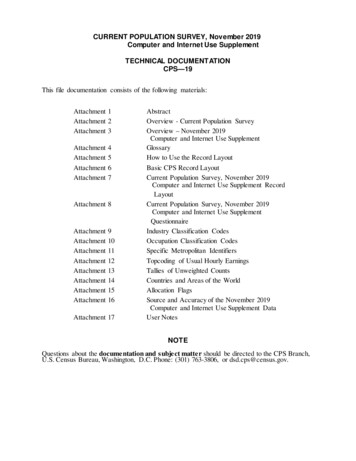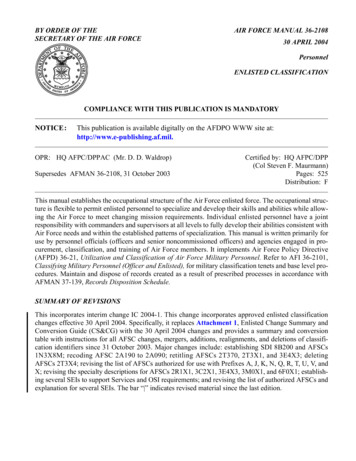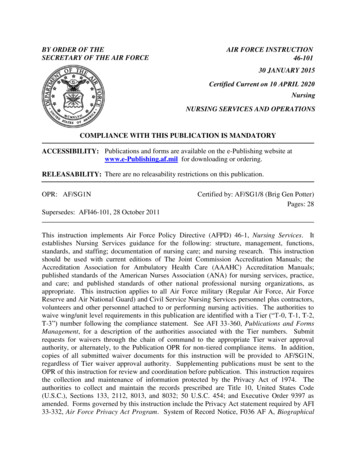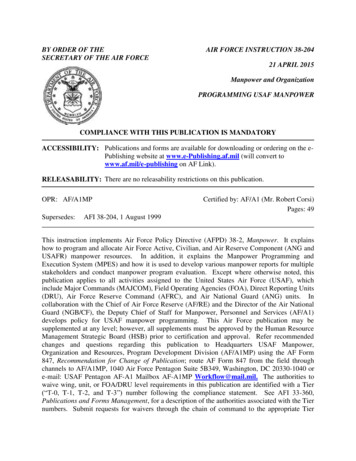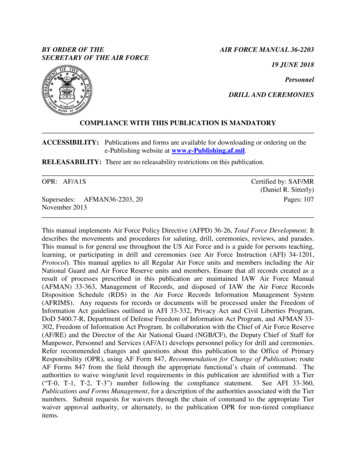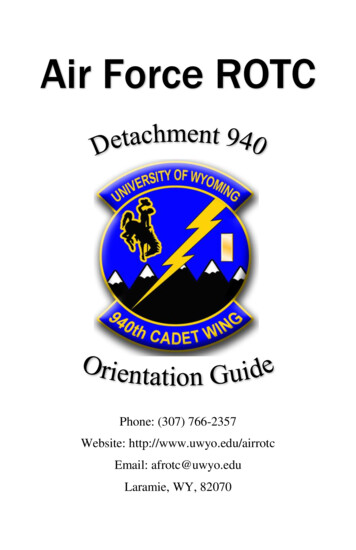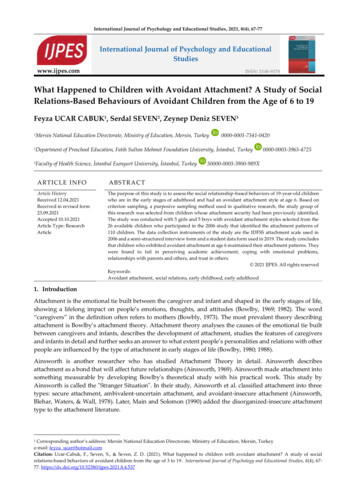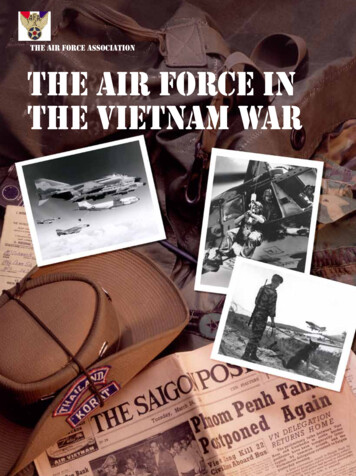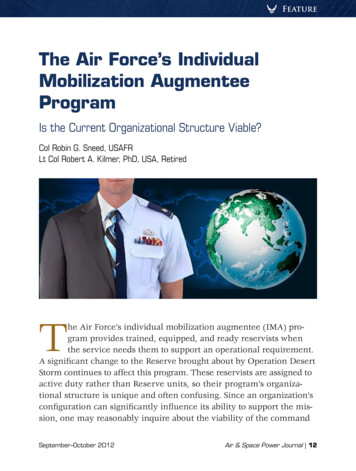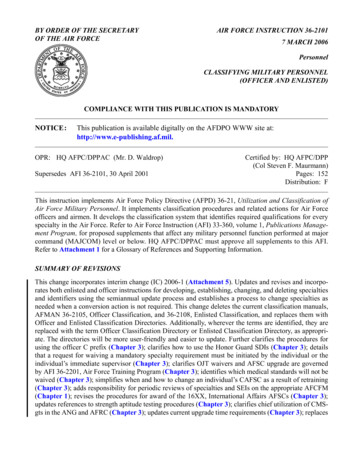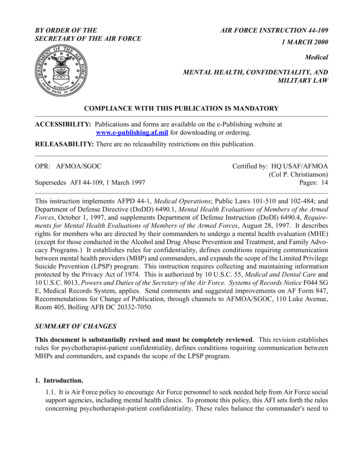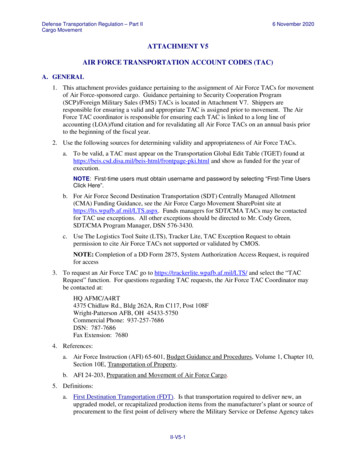
Transcription
Defense Transportation Regulation – Part IICargo Movement6 November 2020ATTACHMENT V5AIR FORCE TRANSPORTATION ACCOUNT CODES (TAC)A. GENERAL1. This attachment provides guidance pertaining to the assignment of Air Force TACs for movementof Air Force-sponsored cargo. Guidance pertaining to Security Cooperation Program(SCP)/Foreign Military Sales (FMS) TACs is located in Attachment V7. Shippers areresponsible for ensuring a valid and appropriate TAC is assigned prior to movement. The AirForce TAC coordinator is responsible for ensuring each TAC is linked to a long line ofaccounting (LOA)/fund citation and for revalidating all Air Force TACs on an annual basis priorto the beginning of the fiscal year.2. Use the following sources for determining validity and appropriateness of Air Force TACs.a. To be valid, a TAC must appear on the Transportation Global Edit Table (TGET) found i.html and show as funded for the year ofexecution.NOTE: First-time users must obtain username and password by selecting “First-Time UsersClick Here”.b. For Air Force Second Destination Transportation (SDT) Centrally Managed Allotment(CMA) Funding Guidance, see the Air Force Cargo Movement SharePoint site athttps://lts.wpafb.af.mil/LTS.aspx. Funds managers for SDT/CMA TACs may be contactedfor TAC use exceptions. All other exceptions should be directed to Mr. Cody Green,SDT/CMA Program Manager, DSN 576-3430.c. Use The Logistics Tool Suite (LTS), Tracker Lite, TAC Exception Request to obtainpermission to cite Air Force TACs not supported or validated by CMOS.NOTE: Completion of a DD Form 2875, System Authorization Access Request, is requiredfor access3. To request an Air Force TAC go to https://trackerlite.wpafb.af.mil/LTS/ and select the “TACRequest” function. For questions regarding TAC requests, the Air Force TAC Coordinator maybe contacted at:HQ AFMC/A4RT4375 Chidlaw Rd., Bldg 262A, Rm C117, Post 108FWright-Patterson AFB, OH 45433-5750Commercial Phone: 937-257-7686DSN: 787-7686Fax Extension: 76804. References:a. Air Force Instruction (AFI) 65-601, Budget Guidance and Procedures, Volume 1, Chapter 10,Section 10E, Transportation of Property.b. AFI 24-203, Preparation and Movement of Air Force Cargo.5. Definitions:a. First Destination Transportation (FDT). Is that transportation required to deliver new, anupgraded model, or recapitalized production items from the manufacturer’s plant or source ofprocurement to the first point of delivery where the Military Service or Defense Agency takesII-V5-1
Defense Transportation Regulation – Part IICargo Movement6 November 2020possession and/or ownership of that item. The procurement source, as used herein, is anysupplier outside the DoD supply system or any DoD industrial activity that fabricates newmateriel. The procurement source or the first point of delivery may be in the ContinentalUnited States (CONUS) or overseas. FDT is not applicable to components or items reworkedby an industrial activity. In the case where the Government accepts the production item at themanufacturer’s plant or source of production and legally owns the item, FDT extends to thefirst point of delivery for either use or storage by the Military Service or Defense Agency.For shipments destined to overseas locations that will enter the Defense TransportationSystem, FDT terminates at the port of embarkation (CONUS or overseas).(1) Free on Board (FOB) origin is a U.S. Government responsibility. Procurement of assetswith Operational and Maintenance (O&M) funds must fund the FDT with O&M typefunds. When procuring assets using procurement appropriations, the procurementappropriation or O&M fund citation will be used to pay for shipping costs. The programoffice will set up a funding document to pay for the anticipated transportation charges.The preferred funding document to use is the Miscellaneous Obligation/ReimbursementDocument (MORD) or Standard Document Number (SDN). Once the MORD isestablished with a LOA and SDN, the program office will ensure the contracting officereceives the LOA and SDN so the contracting office can enter the MORD into LTS,TAC Request. See Paragraph A.3 for Air Force TAC Request guidance. Once the TACis created, this will enable the transportation office to correctly charge the FDT costs.The transportation appropriation chargeable will be taken from DD Form 1653,Transportation Data for Solicitations, Figure V5-1, in the form of a TAC that will beincluded in Section G of FOB Origin contracts.(2) FOB destination is a contractor’s responsibility and the FDT is included in the price ofthe item.b. Second Destination Transportation (SDT). SDT is any transportation other than FDT. Itincludes line-haul, port handling, Outside Continental United States (OCONUS), demurrage,and other charges (e.g., diversion, transportation protective service) incurred in shipment ofAir Force logistics materiel to include door-to-door movement. SDT is paid from three typesof funds: Air Force Working Capital Funds (AFWCF), SDT/CMA O&M funds, and MajorCommand (MAJCOM)/Base O&M funds.(1) AFWCF. The AFWCF is a revolving fund that charges the requisitioner for the itemand for overhead. The overhead charge includes transportation costs for the movementto the requisitioner and return for repair except for OCONUS inland transportation. TheAFWCF includes the following divisions: Materiel Support Division, General SupportDivision, and Medical/Dental Support Division. AFWCF items shipped from a DefenseLogistics Agency (DLA) depot are moved by a DLA TAC.(a) The Air Force base-level supply system identifies AFWCF materiel through the useof the fund code and budget code for each of the WCF Divisions. It automaticallyassigns the TAC to the shipping document, DD Form 1348-1A, IssueRelease/Receipt Document, Figure V5-2) when transportation is the fundingresponsibility of AFWCF. This includes item manager directed redistributionorders, lateral support, return of excess assets, and the return of reparable assets todepot or contractor repair facilities. AFWCF does not pay for movement of assetson loan, in instances of loaned AFWCF assets, the recipient pays the transportationcosts.(b) Redistribution Orders (RDO), Lateral Support, and Reparable Returns. AFWCFwill fund CONUS inland transportation, OCONUS, and inter/intratheaterII-V5-2
Defense Transportation Regulation – Part IICargo Movement6 November 2020movement via the Air Mobility Command (AMC), the Military Sealift Command(MSC), CONUS/OCONUS port handling provided by the Military SurfaceDeployment and Distribution Command (SDDC) Operations Center, andcommercial door-to-door movement. OCONUS inland transportation is theresponsibility of the OCONUS MAJCOM.(2) SDT/CMA O&M Fund. The Air Force SDT/CMA pays for certain movements of nonAFWCF materiel (munitions, aircraft engines, and other investment items listed on aTable of Allowance). The 635th SCOW has financial responsibility for managing theSDT/CMA.(a) Non-AFWCF RDOs. The Air Force base-level supply system identifies itemmanager-directed RDO shipments of non-AFWCF materiel and assigns the TACon the DD Form 1348-1A. The SDT/CMA will fund for CONUS inlandtransportation, inter/intratheater transportation provided by approved commercialair carriers, AMC, MSC, and CONUS port handling services provided by SDDC.OCONUS inland transportation is the O&M funding responsibility of theOCONUS MAJCOM.(b) Non-AFWCF Reparable Returns: The SDT/CMA will fund the return of nonAFWCF serviceable assets from a repair facility. This includes OCONUStransportation provided by AMC and MSC, CONUS port handling servicesprovided by SDDC, and commercial door-to-door movement. The SDT/CMA alsofunds CONUS inland transportation from aerial/sea ports to the repair facility,however, it does not fund the return of a reparable item from a CONUS base todepot. The CONUS base must fund for a reparable return to depot. Overseasinland transportation is the O&M funding responsibility of the overseas MAJCOM.(c) Use the TRACKER website and the “NIIN/TAC Query” to determine the correctTAC to use when the SDT/CMA is responsible for the transportation segment (seeParagraph A.2.c).(3) MAJCOM/Base O&M Funds. These funds will pay for CONUS movement of nonAFWCF assets to a repair facility, lateral support, excess items returned to a depot orstorage site, and items being shipped to a Defense Reutilization and Marketing Office(DRMO). The SDT/CMA will fund OCONUS and inter/intratheater movementprovided by AMC, MSC, and CONUS port handling services provided by SDDC exceptfor DRMO shipments. It will also fund CONUS inland transportation fromAMC/SDDC CONUS aerial/sea ports. OCONUS inland transportation is the fundingresponsibility of the OCONUS MAJCOM.6. Abbreviated Transportation Account Classification (ATAC). Air Force Transportation Officers(TO) are authorized to use ATACs only on bills of lading (BL) movements approved by HQUSAF/ILGD. Four-digit TACs are required on BLs processed through Third Party PaymentSystem (TPPS) billing. Non-Air Force shipping offices are authorized continued use of ATACs.7. TPPS. ATACs and TACs cannot be co-mingled with long-line accounting classifications on thesame BL processed through TPPS. EXCEPTION: AMC aerial ports are authorized to co-mingleTACs and long-line accounting classifications when moving OCONUS-inbound cargo to finaldestinations.II-V5-3
Defense Transportation Regulation – Part IICargo Movement6 November 2020B. GUIDELINES FOR DETERMINING THE AIR FORCE TAC1. Diversions and Misdirected Cargo. The TAC or long line accounting classification appearing onthe shipping document will be used to effect diversion. Shipping activities making diversionswill ensure the TAC is cited. Diversions to Air National Guard (ANG) destinations will cite theANG TAC. For diversions on Air Force-sponsored SCP cargo, see Attachment V7.2. Retrograde. Sea or aerial ports will cite the TAC or ATAC that corresponds to the TAC on theretrograde shipment in order to use commercial modes. For Air Force-sponsored SCP retrogradeshipments, see Attachment V7.3. Munitions/Missile Shipments. Air Force SDT/CMA will only fund movement documentsdirecting shipment of munitions or missiles containing one of the Pacer Ammo Project Codes(121 and 725 through 736) provided by the shipper. If project code BLK is indicated on theshipping documents or in the event a project code is not provided to the transportation office, thenall transportation costs, including OCONUS and port handling, will be borne by thebase/MAJCOM. Additionally, all munitions movements will be approved through the GlobalAmmunition Control Point. Since TACs are not printed by the Combat Ammunition System onthe DD Form 1348-1A document, the TO will determine the TAC based on the National StockNumber (see Paragraph A.2.c). ANG-directed shipments are not a part of the Pacer AmmoProgram and are funded by the ANG.4. Government Purchase Card and Air Force Form 9 (Request for Purchase) Shipments. All costsassociated with these micropurchases, to include transportation, are the responsibility of thepurchaser. If these purchases must move between CONUS and OCONUS using AMC, MSC, orSDDC port handling services, an individual TAC associated with the purchaser’s long LOA mustbe established. An automated TAC request format and procedures for purchases moving via theDefense Transportation System may be accessed at AFMC/LSO LOL website (see ParagraphA.2.b).5. DD Form 1149, Requisition and Invoice/Shipping Document, Figure V5-3. Base organizationspreparing DD Forms 1149 for transportation of assets must cite local funds for CONUSmovement to include movement to a port. For OCONUS movement, units with an individualTAC must provide the TAC on the DD Form 1149. Other TACs for OCONUS movements mustbe determined using the sources in Paragraph A.2. For SDT/CMA shipments, if commercialdoor-to-door proves more economical than AMC, use of the SDT TAC is authorized for the entiremovement.6. ANG. When assets are shipped to an ANG base (Department of Defense Activity Address Code[DoDAAC] F 6000-F 6599), the funding responsibility belongs to the ANG for non-AFWCFasset shipments (RDOs and returns of serviceable assets from depot repair) and lateral supportfrom an active duty AFB. Lateral support shipments of non-AFWCF assets to an active dutyAFB are the funding responsibility of the receiving base. The ANG TAC is F8E0. The shippingbase normally funds all other shipments. When assets are shipped from one ANG base to anotherANG base, O&M/local funds must be used for CONUS shipments. For OCONUS shipments thatare an ANG funding responsibility, use TAC F8E0 to fund inter/intratheater movement. AirForce SDT/CMA will fund movement of assets in support of an Air Expeditionary Forcescontingency.7. Unit Deployment/Redeployment.a. SDT/CMA TAC F8R4 will fund OCONUS movement of shipments initiated by an executedTime Phased Force Deployment Data (TPFDD) plan. Such shipments must bear a mobilityII-V5-4
Defense Transportation Regulation – Part IICargo Movement6 November 2020TCN and a Joint Chiefs of Staff project code associated with an Air Force unitdeployment/redeployment. The long LOA for TAC F8R4 may be viewed at the TGET.b. The unit will fund CONUS inland transportation, and use of the applicable JCS project codeand Emergency and Special Program (ESP) code will ensure their ability to requestreimbursement from their MAJCOM when applicable.c. The SDT/CMA TAC F8R4 will fund both the OCONUS and CONUS return of unit deployedassets to home base. In the return of these assets, units must cite the JCS project code toqualify for use of F8R4. The base or MAJCOM will fund exercise deployment/redeploymentthat is not in direct support of a JCS project code.8. Military Permanent Change of Station (PCS). The TAC for movement of household goods,unaccompanied baggage (UB), and privately owned vehicles using AMC, MSC, and SDDC porthandling services will be cited on the member’s orders. If the TAC is not available on the PCSorders, use the TGET or contact the Air Force TAC coordinator for assistance. The long LOA onthe member’s orders will be used for CONUS movement.9. Civilian PCS. If the TAC is not cited on the employee’s orders, then the TAC from the TGETmust be determined based on whether the civilian position is an appropriated funded ornonappropriated funded position. The long LOA on the employee’s orders will be used forCONUS movement.10. UB for Temporary Duty (TDY) and Dependent Student Travel. Movement of Air Forcesponsored UB for personnel in a TDY or dependent student travel status paid from unit or baseO&M funds must request a specific TAC to pay for AMC movement.11. FMS Supply Discrepancy Report formerly Report of Discrepancy. See Attachment V7.C. BILLING INFORMATIONTAC billing will be made to the “Billed DoDAAC Address” contained in the TGET.II-V5-5
Defense Transportation Regulation – Part IICargo Movement6 November 2020Figure V5-1. DD Form 1653, Transportation Data for SolicitationsII-V5-6
Defense Transportation Regulation – Part IICargo Movement6 November 2020Figure V5-2. DD Form 1348-1A, Issue Release/Receipt DocumentII-V5-7
Defense Transportation Regulation – Part IICargo Movement6 November 2020Figure V5-3. DD Form 1149, Requisition and Invoice/Shipping DocumentII-V5-8
Defense Transportation Regulation – Part IICargo Movement6 November 2020Figure V5-3. DD Form 1149, Requisition and Invoice/Shipping Document (Cont’d)II-V5-9
Defense Transportation Regulation – Part IICargo Movement6 November 2020THIS PAGE INTENTIONALLY LEFT BLANKII-V5-10
accounting (LOA)/fund citation and for revalidating all Air Force TACs on an annual basis prior to the beginning of the fiscal year. 2. Use the following sources for determining validity and appropriateness of Air Force TACs. . Wright-Patterson AFB, OH 45433-5750 Commercial Phone: 937-257-7686 DSN: 787-7686 . Fax Extension: 7680. 4 .
